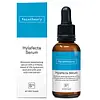What's inside
What's inside
 Key Ingredients
Key Ingredients

 Benefits
Benefits

 Concerns
Concerns

 Ingredients Side-by-side
Ingredients Side-by-side

Water
Skin ConditioningPropanediol
SolventNiacinamide
SmoothingSodium Ascorbyl Phosphate
AntioxidantLactic Acid
BufferingAnethum Graveolens Herb Extract
PerfumingGlycyrrhiza Glabra Root Extract
BleachingSodium Levulinate
Skin ConditioningSodium Benzoate
MaskingGellan Gum
Sodium Retinoyl Hyaluronate
Magnesium Carboxymethyl Beta-Glucan
Skin ConditioningSodium Carboxymethyl Beta-Glucan
CleansingCalcium PCA
HumectantCitric Acid
BufferingPotassium Sorbate
PreservativeWater, Propanediol, Niacinamide, Sodium Ascorbyl Phosphate, Lactic Acid, Anethum Graveolens Herb Extract, Glycyrrhiza Glabra Root Extract, Sodium Levulinate, Sodium Benzoate, Gellan Gum, Sodium Retinoyl Hyaluronate, Magnesium Carboxymethyl Beta-Glucan, Sodium Carboxymethyl Beta-Glucan, Calcium PCA, Citric Acid, Potassium Sorbate
Ingredients Explained
These ingredients are found in both products.
Ingredients higher up in an ingredient list are typically present in a larger amount.
Sodium Benzoate is a preservative. It's used in both cosmetic and food products to inhibit the growth of mold and bacteria. It is typically produced synthetically.
Both the US FDA and EU Health Committee have approved the use of sodium benzoate. In the US, levels of 0.1% (of the total product) are allowed.
Sodium benzoate works as a preservative by inhibiting the growth of bacteria inside of cells. It prevents the cell from fermenting a type of sugar using an enzyme called phosphofructokinase.
It is the salt of benzoic acid. Foods containing sodium benzoate include soda, salad dressings, condiments, fruit juices, wines, and snack foods.
Studies for using ascorbic acid and sodium benzoate in cosmetics are lacking, especially in skincare routines with multiple steps.
We always recommend speaking with a professional, such as a dermatologist, if you have any concerns.
Learn more about Sodium BenzoateWater. It's the most common cosmetic ingredient of all. You'll usually see it at the top of ingredient lists, meaning that it makes up the largest part of the product.
So why is it so popular? Water most often acts as a solvent - this means that it helps dissolve other ingredients into the formulation.
You'll also recognize water as that liquid we all need to stay alive. If you see this, drink a glass of water. Stay hydrated!
Learn more about Water